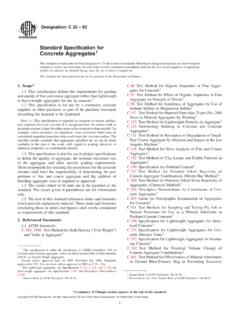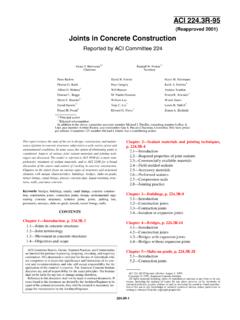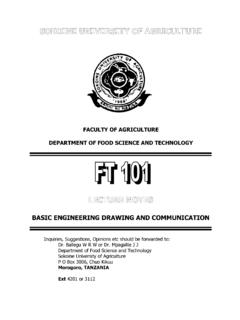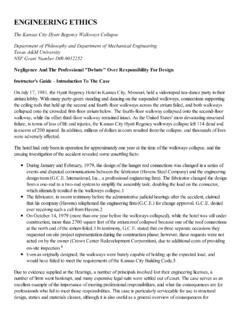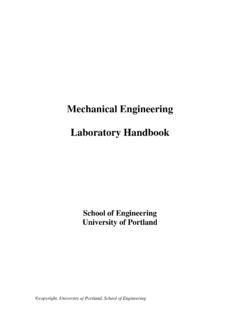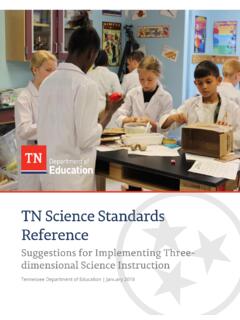Transcription of Standard Practice for Classification of Soils for ...
1 Designation: D 2487 06 Standard Practice forClassification of Soils for engineering Purposes (UnifiedSoil Classification System)1 This Standard is issued under the fixed designation D 2487; the number immediately following the designation indicates the year oforiginal adoption or, in the case of revision, the year of last revision. A number in parentheses indicates the year of last reapproval. Asuperscript epsilon (e) indicates an editorial change since the last revision or Standard has been approved for use by agencies of the Department of Scope* This Practice describes a system for classifying mineraland organo-mineral Soils for engineering purposes based onlaboratory determination of particle-size characteristics, liquidlimit, and plasticity index and shall be used when preciseclassification is Use of this Standard will result in a single classification groupsymbol and group name except when a soil contains 5 to 12 % fines orwhen the plot of the liquid limit and plasticity index values falls into thecrosshatched area of the plasticity chart.
2 In these two cases, a dual symbolis used, for example, GP-GM, CL-ML. When the laboratory test resultsindicate that the soil is close to another soil classification group, theborderline condition can be indicated with two symbols separated by aslash. The first symbol should be the one based on this Standard , forexample, CL/CH, GM/SM, SC/CL. Borderline symbols are particularlyuseful when the liquid limit value of clayey Soils is close to 50. These soilscan have expansive characteristics and the use of a borderline symbol(CL/CH, CH/CL) will alert the user of the assigned classifications ofexpansive The group symbol portion of this system is based onlaboratory tests performed on the portion of a soil samplepassing the 3-in.
3 (75-mm) sieve (see SpecificationE11). As a classification system, this Standard is limited tonaturally occurring The group names and symbols used in this test method maybe used as a descriptive system applied to such materials as shale,claystone, shells, crushed rock, etc. SeeAppendix This Standard is for qualitative application When quantitative information is required for detailed de-signs of important structures, this test method must be supplemented bylaboratory tests or other quantitative data to determine performancecharacteristics under expected field This Standard is the ASTM version of the Unified SoilClassification System. The basis for the classification schemeis the Airfield Classification System developed by A.
4 Casa-grande in the early 1940 became known as the UnifiedSoil Classification System when several GovernmentAgencies adopted a modified version of the Airfield System Standard does not purport to address all of thesafety concerns, if any, associated with its use. It is theresponsibility of the user of this Standard to establish appro-priate safety and health practices and determine the applica-bility of regulatory limitations prior to Practice offers a set of instructions for performingone or more specific operations. This document cannot replaceeducation or experience and should be used in conjunctionwith professional judgment.
5 Not all aspects of this Practice maybe applicable in all circumstances. This ASTM Standard is notintended to represent or replace the Standard of care by whichthe adequacy of a given professional service must be judged,nor should this document be applied without consideration ofa project s many unique aspects. The word Standard in thetitle of this document means only that the document has beenapproved through the ASTM consensus Referenced standards :3C117 Test Method for Materials Finer than 75- m ( ) Sieve in Mineral Aggregates by WashingC 136 Test Method for Sieve Analysis of Fine and CoarseAggregatesC 702 Practice for Reducing Samples of Aggregate toTesting SizeD 420 Guide to Site Characterization for engineering De-sign and Construction PurposesD 422 Test Method for Particle-Size Analysis of SoilsD 653 Terminology Relating to Soil, Rock, and ContainedFluids1 This Standard is under the jurisdiction of ASTM Committee D18 on Soil andRock and is the direct responsibility of Subcommittee on Identification andClassification of edition approved May 1, 2006.
6 Published June 2006. Originallyapproved in 1966. Last previous edition approved in 2000 as D 2487 , A., Classification and Identification of Soils , Transactions,ASCE, 1948, p. referenced ASTM standards , visit the ASTM website, , orcontact ASTM Customer Service at ForAnnual Book of ASTMS tandardsvolume information, refer to the Standard s Document Summary page onthe ASTM *A Summary of Changes section appears at the end of this ASTM International, 100 Barr Harbor Drive, PO Box C700, West Conshohocken, PA 19428-2959, United 1140 Test Method for Amount of Material in Soils FinerThan the No. 200 (75- m) SieveD 2216 Test Methods for Laboratory Determination of Wa-ter (Moisture) Content of Soil and Rock by MassD 2217 Practice for Wet Preparation of Soil Samples forParticle-Size Analysis and Determination of Soil Con-stantsD 2488 Practice for Description and Identification of Soils (Visual-Manual Procedure)D 3740 Practice for Minimum Requirements for AgenciesEngaged in the Testing and/or Inspection of Soil and Rockas Used in engineering design and ConstructionD 4083 Practice for Description of Frozen Soils (Visual-Manual Procedure)
7 D 4318 Test Methods for Liquid Limit, Plastic Limit, andPlasticity Index of SoilsD 4427 Classification of Peat Samples by Laboratory Test-ingD 6913 Test Methods for Particle-Size Distribution (Grada-tion) of Soils Using Sieve AnalysisE11 Specification for Wire Cloth and Sieves for TestingPurposes3. Except as listed below, all definitions arein accordance with TerminologyD For particles retained on a 3-in. (75-mm) Standard sieve,the following definitions are suggested:Cobbles particles of rock that will pass a 12-in. (300-mm) squareopening and be retained on a 3-in. (75-mm) Standard sieve, andBoulders particles of rock that will not pass a 12-in. (300-mm) soil passing a No.
8 200 (75- m) standardsieve that can be made to exhibit plasticity (putty-like proper-ties) within a range of water contents and that exhibitsconsiderable strength when air dry. For classification, a clay isa fine-grained soil, or the fine-grained portion of a soil, with aplasticity index equal to or greater than 4, and the plot ofplasticity index versus liquid limit falls on or above the A particles of rock that will pass a 3-in. (75-mm) sieve and be retained on a No. 4 ( ) standardsieve with the following subdivisions:Coarse passes 3-in. (75-mm) sieve and retained on3 4-in.(19-mm) sieve, andFine passes3 4-in. (19-mm) sieve and retained on No. 4( ) clay a clay with sufficient organic content toinfluence the soil properties.
9 For classification, an organic clayis a soil that would be classified as a clay except that its liquidlimit value after oven drying is less than 75 % of its liquid limitvalue before oven silt a silt with sufficient organic content toinfluence the soil properties. For classification, an organic siltis a soil that would be classified as a silt except that its liquidlimit value after oven drying is less than 75 % of its liquid limitvalue before oven a soil composed of vegetable tissue in variousstages of decomposition usually with an organic odor, adark-brown to black color, a spongy consistency, and a textureranging from fibrous to particles of rock that will pass a No.
10 4 ( ) sieve and be retained on a No. 200 (75- m) standardsieve with the following subdivisions:Coarse passes No. 4 ( ) sieve and retained on ( ) sieve,Medium passes No. 10 ( ) sieve and retained onNo. 40 (425- m) sieve, andFine passes No. 40 (425- m) sieve and retained on (75- m) soil passing a No. 200 (75- m) standardsieve that is nonplastic or very slightly plastic and that exhibitslittle or no strength when air dry. For classification, a silt is afine-grained soil, or the fine-grained portion of a soil, with aplasticity index less than 4 or if the plot of plasticity indexversus liquid limit falls below the A of Terms Specific to This cient of curvature, Cc the ratio (D30)2/(D103D60)

